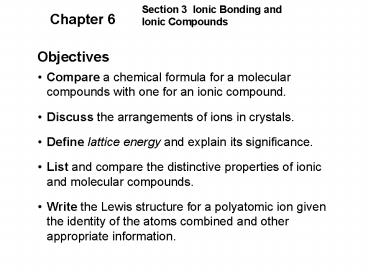Objectives - PowerPoint PPT Presentation
1 / 16
Title:
Objectives
Description:
Write the Lewis structure for a polyatomic ion given the identity of the atoms ... Visual Concepts. Comparing Monatomic, Polyatomic, and Diatomic Structures. Chapter 6 ... – PowerPoint PPT presentation
Number of Views:31
Avg rating:3.0/5.0
Title: Objectives
1
Section 3 Ionic Bonding and Ionic Compounds
Chapter 6
Objectives
- Compare a chemical formula for a molecular
compounds with one for an ionic compound. - Discuss the arrangements of ions in crystals.
- Define lattice energy and explain its
significance. - List and compare the distinctive properties of
ionic and molecular compounds. - Write the Lewis structure for a polyatomic ion
given the identity of the atoms combined and
other appropriate information.
2
Section 3 Ionic Bonding and Ionic Compounds
Chapter 6
Ionic Compounds
- Most of the rocks and minerals that make up
Earths crust consist of - example
- An ionic compound is
3
Section 3 Ionic Bonding and Ionic Compounds
Chapter 6
Ionic Compounds
- Most ionic compounds exist as
- A crystal of any ionic compound is
- In contrast to a molecular compound, an ionic
compound is not
4
Section 3 Ionic Bonding and Ionic Compounds
Chapter 6
Ionic Compounds, continued
- The chemical formula of an ionic compound
represents not molecules, but - A formula unit is
5
Ionic Vs. Covalent Bonding
Section 3 Ionic Bonding and Ionic Compounds
Chapter 6
6
Section 3 Ionic Bonding and Ionic Compounds
Chapter 6
Formation of Ionic Compounds
- The sodium atom has ______ valence electrons and
the chlorine atom has ________ valence electrons. - Atoms of sodium and other alkali metals easily
- Atoms of chlorine and other halogens easily
7
Section 3 Ionic Bonding and Ionic Compounds
Chapter 6
Formation of Ionic Compounds, continued
- In an ionic crystal, ions minimize their
potential energy by combining in an orderly
arrangement known as a ___________ __________. - .
- .
- The combined attractive and repulsive forces
within a crystal lattice determine - .
- .
8
NaCl and CsCl Crystal Lattices
Section 3 Ionic Bonding and Ionic Compounds
Chapter 6
9
Section 3 Ionic Bonding and Ionic Compounds
Chapter 6
A Comparison of Ionic and Molecular Compounds
- The force that holds ions together in an ionic
compound is - In contrast, the forces of attraction between
molecules of a covalent compound are - This difference in the strength of attraction
between the basic units of molecular and ionic
compounds gives rise to ____________
______________ between the two types of compounds.
10
Section 3 Ionic Bonding and Ionic Compounds
Chapter 6
A Comparison of Ionic and Molecular Compounds,
continued
- Molecular compounds have
- They melt at
- The strong attraction between ions in an ionic
compound gives ionic compounds some
characteristic properties, listed below. - .
- .
- .
11
How to Identify a Compound as Ionic
Section 3 Ionic Bonding and Ionic Compounds
Chapter 6
12
How to Identify a Compound as Ionic
Section 3 Ionic Bonding and Ionic Compounds
Chapter 6
13
Section 3 Ionic Bonding and Ionic Compounds
Chapter 6
Polyatomic Ions
- Certain atoms bond covalently with each other to
form a group of atoms that has both ____________
and ________ characteristics. - Define polyatomic ion
- Like other ions, polyatomic ions have a charge
that results from either a ____________ or
_________ of electrons.
14
Section 3 Ionic Bonding and Ionic Compounds
Chapter 6
Polyatomic Ions
- An example of a polyatomic ion is the ammonium
ion . It is sometimes written as
____________ to show that the group of atoms as a
whole has a charge of
- The charge of the ammonium ion is determined as
follows - .
15
Section 3 Ionic Bonding and Ionic Compounds
Chapter 6
Polyatomic Ions, continued
- Some examples of Lewis structures of polyatomic
ions are shown below.
16
Comparing Monatomic, Polyatomic, and Diatomic
Structures
Visual Concepts
Chapter 6































